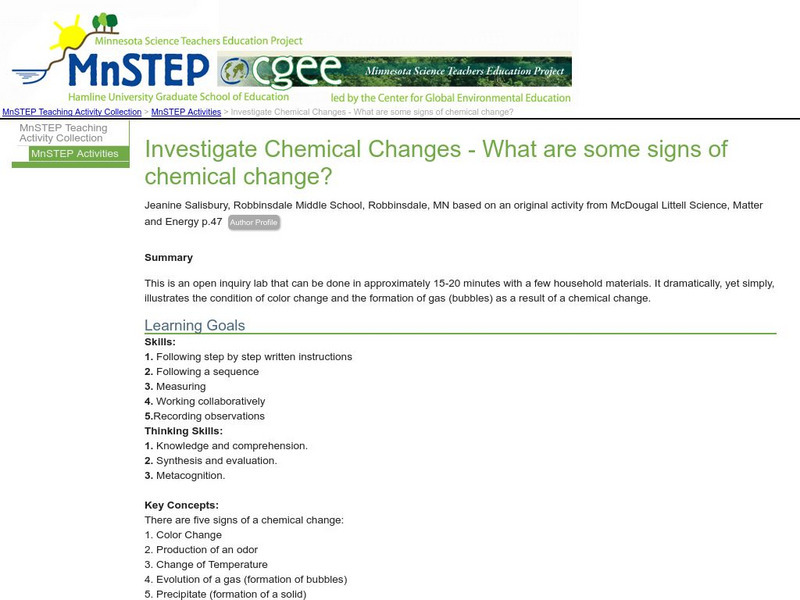Curated OER
Transforming Energy
Sixth graders study about alternate energy sources and discuss with their neighbor how alternative energy sources affect environmental conditions so that an entire species could be affected.
Curated OER
Unity In Diversity
Pupils discuss the meaning of diversity in the world. They practice how to act around others and appreciate the different types of people that exist. The lesson includes a section of vocabulary and the reading of a story to illustrate...
Curated OER
Periodic Table & Its Trends
Students review atomic structure and then participate in a activity in which they categorize several "elements" into some form of order based on their properties. They discuss the trends they see. They also practice several electron...
Curated OER
Rocks Unit
Young scholars learn about all types of rocks through a unit study consisting of 6 days. They are doing activities such as illustrating rocks, answering questions on a worksheet, reading, and reviewing questions. After the end of each...
Curated OER
Organization of the Elements and Periodic Table
Students identify how to relate the position of an element in the periodic table to its atomic number and atomic mass. They also identify and interpret how to use the periodic table to identify metals, semimetals, nonmetals, and...
Curated OER
Eight Basic Elements of the Earth
Students identify the concept of an element and work with an idea that all of the millions of substances on the earth are various combinations of only 8 elements. They work with the Periodic Table of the Elements and symbols of the...
Curated OER
Mineral Munch
Second graders explore the sodium content in foods they eat. After observing a table setting, 2nd graders then identify items made from rock. They taste low sodium crackers and compare them to regular crackers. Students discuss the...
Curated OER
Ecology
Sixth graders are introduced to online research and beginning PowerPoint presentations that are integrated. They pass a plant and photosynthesis. Students locate information on a self selected animal online. They give a PowerPoint...
Curated OER
Sedimentary Rocks
In this sedimentary rock worksheet, students define clastic and bioclastic. Students determine how dolostone is formed and the difference between breccia and conglomerate. This worksheet has 11 short answer questions.
Curated OER
Acid and Base Worksheet
In this acids and bases worksheet, students apply the Bronsted-Lowry theory of acids and bases to write the products for the given acid-base reactions. This worksheet has 7 problems to solve.
Curated OER
Landfills and Dumps
For this environmental issues worksheet, students learn about sanitary landfills and dumps by reading a one page information text. Students also study the cross section of a landfill. There are no questions to answer.
Curated OER
Dig Magazine Archeology Quiz #106
In this Dig Magazine archeology quiz, students answer 12 multiple choice questions complementing the October 2009 issue. Page contains answer and additional resources link.
Curated OER
Biology Honors Final Project
Tenth graders work on a project about cellular biology and genetics. In this biology instructional activity, 10th graders research about the assigned human body system and genetic disorders that affect it. They create a multimedia...
Curated OER
Breaking News English: Londoners Offered BLT for SAD
In this English worksheet, students read "Londoners Offered BLT for SAD," and then respond to 47 fill in the blank, 7 short answer, 20 matching, and 8 true or false questions about the selection.
Curated OER
Art Nouveau
Students study the design elements of Art Nouveau, its sources and development. They create art projects in ceramics and glass that exemplify the focus of Art Nouveau as a decorative style.
Georgia Department of Education
Ga Virtual Learning: Physical Science: Bonding and Chemical Reactions
Through informational text, interactive puzzles, and review questions, students differentiate ionic and covalent bonds and identify the properties of each. They also use oxidation numbers to predict formulas of ionic compounds, name...
Georgia Department of Education
Ga Virtual Learning: Chemistry: Chemical Formulas and Equations
In this interactive module, students are introduced to the most fundamental part of chemistry: chemical reactions and the formulas that accompany them.
Texas Instruments
Texas Instruments: Naming Chemical Compounds
This activity is designed to assess the comprehension of concepts related to naming chemical compounds.
Texas Instruments
Texas Instruments: Naming Chemical Formulas
This Study Card stack will provide additional review for naming chemical compounds and chemical formulas.
Crescent Public Schools
The Internet Science Room: Naming Chemical Formulas
Students can use this chemistry tutorial to help them understand how to name chemical formulas.
Science Education Resource Center at Carleton College
Serc: Investigate Chemical Changes: What Are Some Signs of Chemical Change?
This lab illustrates the condition of color change and the formation of gas (bubbles) as a result of a chemical change. Students will be able to name the characteristics of chemical changes.
Alabama Learning Exchange
Alex: Name That Change!
This lesson teaches students to distinguish between physical and chemical changes. Students will view an interactive slideshow presentation and then conduct experiments to discern physical and chemical changes.
Texas Instruments
Texas Instruments: Naming and Writing Formulas of Acids
This StudyCard activity will enable students to practice naming and writing formulas for binary and non-binary inorganic acids. This activity will also allow students to practice naming acids found in aqueous solution as well as those...
Simon Fraser University
Chem1 Virtual Textbook: Naming Chemical Substances
As part of the "Basic Atomics" section of the Virtual Textbook, this site examines basic chemical nomenclature and covers a variety of subjects related to chemical substances. Other topic covered include naming the elements, binary...























